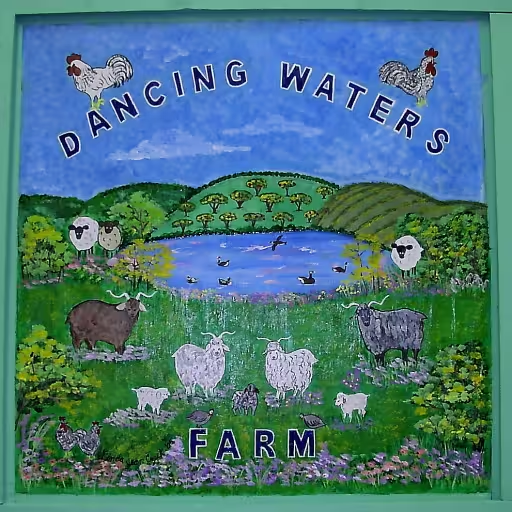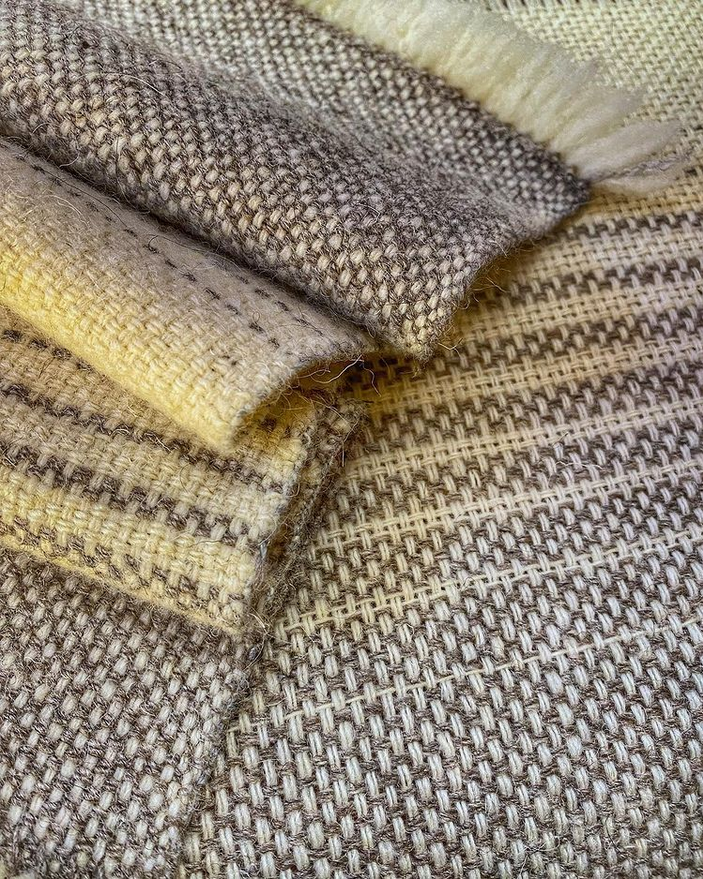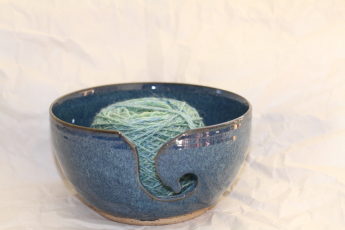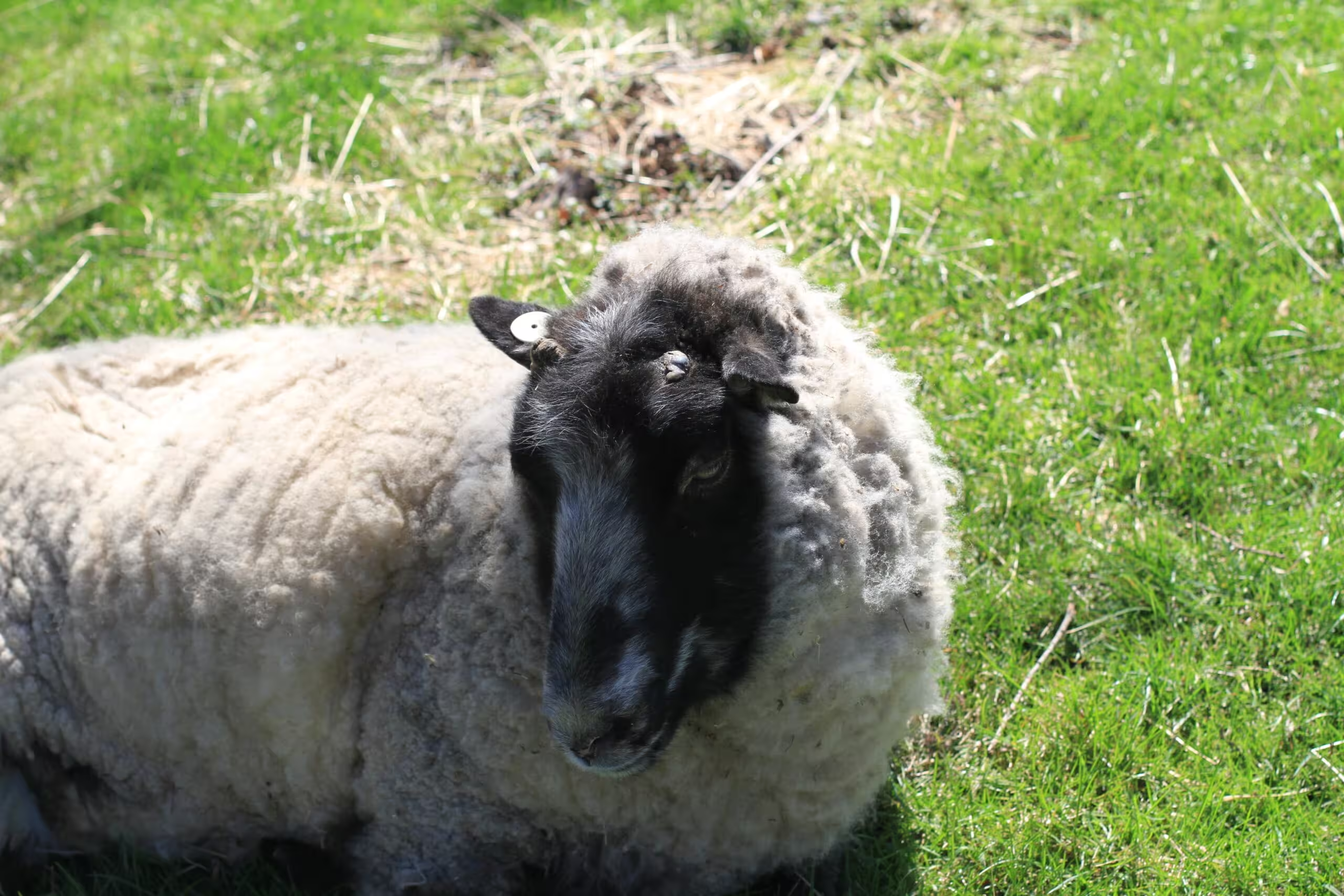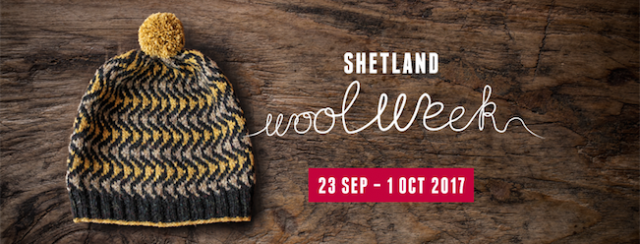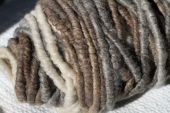
2017 Year in Pictures
Gallery
This gallery contains 31 photos.
Fresh Small Farm Eggs vs Fresh Grocery Store Eggs
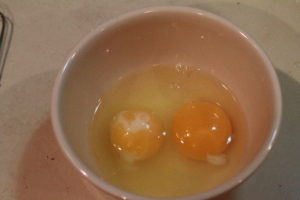
Shop Rite Egg (left) vs DWF Egg (right)
The photo says it all. Had to buy eggs for holiday baking as my ladies are still molting (so not producing many eggs at the moment).
Last Mechanical Loom Mill Making Jeans in US Closing Dec 2017

Cone Denim’s White Oak plant in Greensboro, North Carolina. Unlike most other textile plants in the U.S., White Oak has always produced nothing but denim. In the late 1800s, the plant’s owners, Cone Denim, sold Levi Strauss his first wholesale supplies, soon therafter filing the original patents on selvage denim. photo courtesy of Cone Denim, LLC, a division of International Textile Group
The facility closing at the end of the year is using looms built in the 1940s (!) which uses shuttles like traditional looms. At 3 passes of through the warp per second they are clearly more technologically savvy than hand powered looms. They make a sturdier cloth than modern looms because the weft (horizontal fibers that are woven through the warp which are the vertical fibers) is continuous, it goes back and forth across the weft all the way through the cloth. Modern looms cut the weft at the end of each pass (and use air jets to propel the fiber!) because the width of the loom is too wide to use shuttles.
The other interesting aspect of these older looms is that the motion of the shuttles on a wood floor causes small imperfections in the weave that give the cloth a unique look that isn’t found in cloth produced on a “modern” loom. In addition, vintage jeans were also dyed with indigo plants (vs synthetic indigo) and only the warp threads are dyed to give the finished fabric that familiar worn blue color (blue warp, white weft).
Primarily cheaper labor in other countries (Turkey) caused this plant closing. The looms (Draper X3 manufactured in Hopedale, MA) are being bought up by other small specialty startup mills so there is hope that they will some day be making quality cloth in the US again.
Source: https://craftsmanship.net/secret-vintage-jeans/
Science in Support of Small Farms – Micronutrient Maps
That different foods provide different essential micronutrients (such as calcium, vitamin A, and folate) isn’t news. But now we know which farms produce the most. New research published in the inaugural issue of The Lancet Planetary Health is the first to map production of micronutrients worldwide on farms of different sizes, spanning 41 crops, 7 livestock products, and 14 fish groups.
The study was led by Mario Herrero, of the Commonwealth Scientific and Industrial Research Organisation, Australia, and co-authors include Paul West, James Gerber, and Leah Samberg of IonE’s Global Landscapes Initiative. The researchers discovered that worldwide, small and medium farms (≤ 50 ha.) produce more than half (51–77 percent) of nearly all commodities and nutrients examined in the study. Other key findings include:
- Large farms (> 50 ha.) reign in North America, South America, Australia, and New Zealand, contributing 75–100 percent of cereal, livestock, and fruit production—while small farms (≤ 20 ha.) account for more than 75 percent of food production in Sub-Saharan Africa, Southeast Asia, South Asia, and China
- The majority of global micronutrients (53–81 percent) and protein (57 percent) are produced in more diverse agricultural landscapes
- The diversity of agricultural and nutrient production diminishes as farm size increases—but areas of the world with higher agricultural diversity
A new interactive Food Matters report, Small Farms: Stewards of Global Nutrition?, complements the study and highlights the key findings. Published by the Institute on the Environment, Food Matters reports—including its graphs, infographics, and other data visualizations—are freely shared under a Creative Commons license.
Excerpted from: https://phys.org/news/2017-10-micronutrients-importance-small-medium-farms.html
Original article: Mario Herrero et al. Farming and the geography of nutrient production for human use: a transdisciplinary analysis, The Lancet Planetary Health (2017). DOI: 10.1016/S2542-5196(17)30007-4
USA Made Super Wash Wool and Other Purchasing Decisions
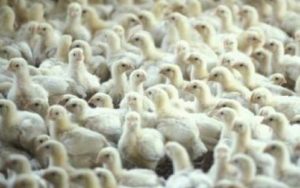 Commercial “Free Range” Egg Production Photo from University of MD extension website |
Versus |
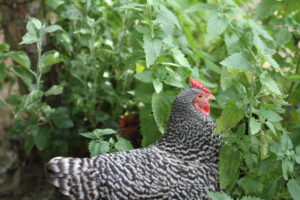 Dominique Laying Hen at Dancing Waters Farm |
Installing a super wash processing facility in the USA back in 2011 allowed the production of 100% USA produced commercial wool products for the first time. It rescued the American wool industry which could not compete with wool products made in other countries since USA produced wool had to be sent over seas to be super wash processed. Good or bad, in order for wool to compete with other fibers used in cloth/ yarns it needs to be super wash processed so it can be machine washed. A blog article by Pigeonroof Studios gives a good overview of the historical details and impacts of opening this super wash facility, in particular with respect to environmental issues.
The article is focused on large commercial producers, so when it says “Chargeurs is the only remaining top making facility in the United States, and one of only two remaining commercial scouring facilities.” it is excluding small USA fiber mills. I have my tops processed by Zeilinger’s in Michigan for example, but they are one of the few mills that process tops in small lots (10 pounds minimum raw, 5 pounds minimum washed). The other thing that has happened recently is that the military cancelled their contract for American wool and although it ‘s certain to have a negative impact on the US wool industry, it won’t be as bad as it would have been 5 years ago as many other commercial users are now taking advantage of the facility (socks for consumers, etc.). Chargeurs is still the only super wash facility in the USA but the minimums are too large for small producers unless they combine lots with other small producers.
The real issue with farming is that it is so labor intensive that the real cost of producing anything (eggs, vegetables, wool, mohair, etc.) is so high that no one will buy it at true cost. Eggs would sell for about $9/dozen to be equal to what they sold for back in the 1920s, after adjusting only for inflation/ value of the dollar changes.
The only way to make a profit is by economies of scale, using the cheapest possible ingredients, practices that reduce labor costs and depending on government subsidies. This translates into poorer feed quality, smaller living quarters (ridiculously small for chickens and pigs) and less attention to health in animals and large scale use of herbicides/ pesticides/ genetically modified plants and large equipment in the case of plant crops.
A somewhat humorous sidebar is that John Deere makes more money financing than selling equipment. [See: https://www.statista.com/statistics/271866/john-deere-net-sales-since-2001/which shows $23B in sales, net income $1.5B in 2016 from equipment, but $2.7B from financing (look at revenue by segment to get amount from finance)]. They are making their money by financing bigger and more expensive equipment to farmers who are trying to keep their economies of scale large enough to pay their bills (those big tractors can easily cost $500,000).
That’s why the majority of small farms have a second job to pay the bills that can’t be paid with their farm sales. Keep this is mind when you’re buying farm products. Do you want to use your money for products that have been produced using the best sustainable practices (kind to the environment) and which provide animals humane care or do you only care about the cheapest product? This is a social issue which receives very little discussion. I believe there has to be a way to feed and cloth people including those with limited means as well as pay the producers (small farmers) what it costs to produce the items and provide some profit. Small farmers are doing what we do for the perks: enjoying and assuring good life for animals and the environment, the ability to work in the great outdoors and to be our own boss. However, I believe they should be earning at least minimum wage for their efforts.
Sock Knitting Exploration – Version 2
My second project ….
Used FLK (Fish Lip Kiss) pattern for sizing and heel. I used Turkish Cast On and Magic Loop from the toe up approach. This pair was done on two circulars, and I did an inch on one sock then an inch on the other sock in order to avoid the dreaded SSS (single sock syndrome). Still not quite ready for two at a time Magic Loop! It took me about 15 hours of knitting for the pair which was dramatically better than for the 1st pair (>40 hours). I can only hope this trend will continue!
The yarn used for the sock body was Rambler’s Way Handpaint Rambouillet DK (100% American raised wool and spinning) which is spun with a high twist. The heels were done in a worsted 2ply 100% mohair yarn which was very slippery and hard to knit with to keep about the same gauge as the sock body.
I also tried “Feeding Ducks and Holding Hands” stitch pattern for the top of the sock body (available as a scarf pattern free on Ravelry). I converted it to a knit only version (it’s written as a purl version). The knit version is initially slightly more difficult to do than as a purl version, but easy enough as long as the stitches are not made too tightly. Loved this stitch pattern as it’s easy to do as well as remember (no need to keep checking the pattern!) and looks fantastic with this kind of yarn (relatively short color repeats).
Due to the size of the yarn they don’t fit in regular shoes but are fine in boots or slippers.
Now to test wear ability vs version 1!

Learnings:
100% mohair is slippery and more difficult to knit with than all wool. Up to this point had only knit with my 75% mohair – 25% wool roving/ tops that had been handspun.
Next….Same pattern, but using superwash wool with 25% nylon ie-classic sock yarn. Already not happy with my choice – took 4 hours to convert the skein into a center pull ball. It’s also a very slippery yarn. The superwash process removes the scales from the wool (so it won’t felt) which not surprisingly makes the yarn slippery vs regular wool.
Project info
Socks Version 1
Socks Version 2
Socks Version 3
Commercial Cage Free Egg Production – Bigger Cage, Just As Crowded
This video promotes an engineering feat – the industrialization of cage free buildings for egg production.
https://cagefree.summitlivestock.com/
Even thinking about producing 1.1 billion eggs in only 10 layer houses in only 3 sites in the US is scary. They never show how the building looks from the inside (ie-hen view) but it’s pretty clear from the other video stills/links provided at the end how it will be. The “cage” is bigger and the amount of space provided is pretty much the same – way too small for a living animal.
People think they are doing a good thing by buying cage free eggs but big industry has figured a way to claim the tag phrase without allowing the hens to live like chickens. “Free range” has similar issues although arguably somewhat better for the hens as they are only crammed wing to wing at night (vs 24 x 7).
Use your money to provide good lives for hens by buying your eggs from a local small farmer where the hens ARE cage free!

Dominique Hen Looking at Catnip
Late Winter on the Farm
It’s been a busy time for farm and wildlife activities over the last month. The weather has been quite capricious as well. I knew there would be payback for the lovely warm February this year!
Chicken Traumas….
On President’s day Regina (Salmon Favorelle hen 3 years old )
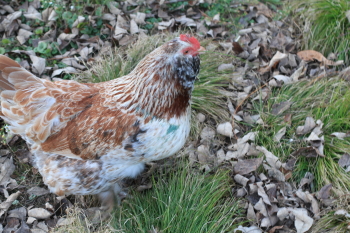
Regina – Favorelle Hen
was pecked on the head so severely by Coq Au Vin (Easter Egger rooster 1 year old)
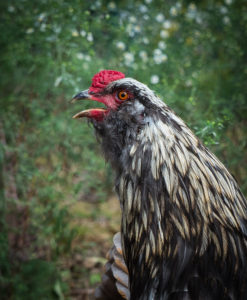
Coq Au Vin – Photo courtesy of
that the skull was visible. She made a full recovery in about 2 weeks which is yet another testament to their healing abilities and tolerance for pain (good old fashion toughness and strong will to live!).
The rooster had been picking on some of the older hens, just warning them away from his favorites, but not anything serious up to this point. My experience is that roosters that lives with a smaller group of hens will prefer them if they are then all released into a larger group. This rooster had been raised with his “sisters” until about 8 weeks when he began to be too aggressive and he was moved to a pastured area with 1 year old hens. After initial dissatisfaction (had to clip his wings to keep him in their area!), he settled in, got on with them very well and they loved him too. I’d never had a rooster attack a hen and cause such a significant wound. I put him in his own area and it was quickly clear that he’d been terrorizing some others as well because they stopped hiding within a few days. I’d thought it was hen disagreements causing the slight dissension in the main group.
Since Coq Qu Vin is very good with people I decided to re-home him thinking that starting off with a new flock he wouldn’t have any prejudices. I found a nice home for him and thought things were going well as there was no word for almost 3 weeks but alas he decided he did not like Buff Orpington hens either and he came home again. He’s in his own pen with a view of the ladies while I decide my next approach. I’m thinking of letting him run loose outside the chicken yard and roost in the greenhouse overnight.
Around the same time one of my Australorp hens broke a thigh bone completely (snapped in half) in two separate spots – one in the center of the bone, one just below the pelvis joint. No idea what happened but she was suffering greatly although she valiantly moved around using a wing to support herself on the bad leg side. She did not make it, the injury was just too severe. Most animals have appetite loss if they are in severe pain which causes them to go down, not the injury itself.
Also a Dominique hen (KFC – so named because she loves “fast food” aka corn) tore a growth off her leg which bled for a long time despite my attempts to stop the bleeding. After a week in the greenhouse with a bandage on her leg she was doing so well that I returned her to the geriatric hen pasture to complete her recovery.
Goat Issues…
The (presumably benign) tumor on James’s (12 year old Angora goat) throat finally got to a critical stage. He’s had it for over a year and I had a vet look at it soon after I first noticed it. The opinion was that it was inoperable because of the location. So…had not been looking forward to what was going to happen with him over time. The tumor had grown quite large and reached the point where his skin couldn’t stretch any more, bursting open so that he was draining fluids from the opening continually.
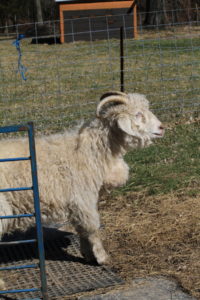
Since fly season was approaching and he was clearly not feeling good I decided to have the vet try to remove the tumor, knowing that there was a good chance he might not make it through the surgery. A big snowstorm was expected (>2″ predicted) and the vet wanted to do it the day of the storm as all his other patients had cancelled and he could focus on the difficult procedure. So… James went to the Vet the night before the storm and while my entire day was spent shoveling James surprised all of us by surviving the surgery in great shape.
He spent 5 days in the garage at night and in a stall in the barn during the days so he could be easily monitored in a sheltered, more sterile area. He has progressed nicely and is happily re-united with his brother out in his regular pasture. I still have to borrow the staple remover from the vet and take all the staples out but hope to do this early next week. His voice is normal again but he’s still coughing and choking more than normal. Hopefully that will slowly improve as all the muscles in his neck and throat heal.
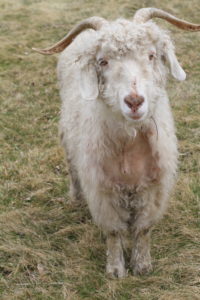
Of course he had to give me a good scare the other night. I went out to do the evening feeding and couldn’t find him. Finally I see him on the ground at the far end of a remote pasture. I call to him and there is not motion so I start running and I can’t tell he’s alive until I touch him. Then he shifts his eyes to look at me pleadingly but patiently. He had managed to get tangled up in the electric net fence intended to keep the boys from knocking heads with the girls through the main fence. There was no electricity involved, it was just being used as a visual and soft physical barrier. He was perfectly fine after I got all the wires off his horns and front legs although he was grinding his teeth (normally a sign of pain) and for a bit I thought the plastic wires had sawed into his skull at the base of the horns. Thankfully the wires were only caught on an imperfection on his horn. Needless to say this means they won’t be using that pasture again until I can work out a better barrier. Unfortunate as it has better grass than their “home” pasture and they had been using that pasture with that fencing for months now without issue!
Bunny Mishaps….
At the end of March a baby bunny (eyes still closed) was found on the main path into the chicken yard with one eye pecked partially open and a large wound on it’s back. Since the bunny was very cold it was brought into the house to be re-warmed. There was no sight of a nest even after repeated attempts to locate one so the bunny stayed in the house while I put a game camera up over night to locate the nest.
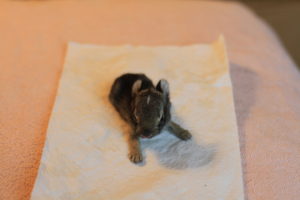
I was able to use the game camera pictures to find the bunny nest after a few tries. There were two more rabbits in the nest also with pretty full coats and eyes closed, ears down (thus <a week old). They were in the compost pile which was pretty wet due to the recent rain and full of goat poop and smelly hay as this is where the mess from the barn ends up. I imagine this was the only place the mother could dig since the ground was snow covered from the 14 inch snow we received the week prior and the lack of any real warmup to significantly melt the snow since then. It has been the second incidence of a 60 degree day followed by a significant snowfall this year.
It was safe in that it was a fenced area with electric lines around it but not safe for baby bunnies wriggling out of their nest and attracting chickens looking for snacks. The short version of events is that after several attempts to reinforce and better water proof the nest, the mother wasn’t able to find them (even though it was in the spot she had put them in) and the injured one as well as another kept escaping from the nest and striking out for parts unknown. Since they were escaping through the fence around the compost pile there was no way to ensure their safety during the day (chickens) nor a way to keep them safe from Mother Nature at night in between feedings by their mother IF she could find them.
Unfortunately rabbits are very difficult for people to raise. They require a formula that is very high in fat and protein (not even goat’s milk at 43% fat is sufficient, cow’s whole milk is 5%) plus the killer issue is they must eat a bit of their mother’s night time poop preferably every day. Yes, there are 2 kinds of rabbit poop – dry pellets and a smelly, gooey kind they do at night. Fresh poop is needed in order to inoculate their intestines with the proper bacteria to digest the fiber in greens (grass, etc.). Without rabbit poop in their diet they will quickly die once they start eating greens. So if you don’t own a rabbit or know someone nearby with a healthy domestic rabbit and are not willing to spend $60 for the proper formula, orphaned baby rabbits are history. I had been keeping the injured bunny going on goat’s milk since that was the highest fat and protein milk I could easily find and had been hoping to get the orphan back into it’s nest ASAP. Keeping the bunny warm and avoiding dehydration were my main goals.
Once I decided I couldn’t keep any of them in their nest, I started looking for a wildlife rehabilitator that handles rabbits. The NJ Association of Wildlife Rehabilitators provides a list of NJ state licensed rehabilitators on their website. Luckily Woodlands Wildlife Refuge is located fairly close to the farm and they rehabilitate rabbits. I talked to them and they agreed the situation here at the farm could not be remedied so I dropped the bunnies off for them to raise. The bunnies opened their eyes the evening before I dropped them off and they weighed 1.8 (the injured one) to 2.1 ounces! Their eyes typically open at about 7 days. The injured bunny had healed very well and the injured eye completely opened a day before the other eye. It might end being blind in the eye that got pecked, too early to tell but it looked clean and healthy at the time I dropped the bunnies off at the rehabilitators.
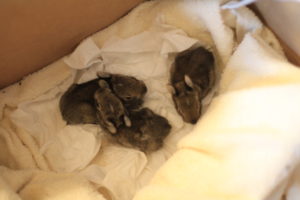
If you are interested in knowing more about raising orphaned rabbits and general information on their unique needs and growth benchmarks there is an excellent website created by Ron Hines (a vet) who covers health topics on both domestic pets and common wildlife rescue info. The injured bunny really touched my heart because it had such a strong will to live and was able to accommodate all the changes in it’s short life: learning to drink from a syringe and have it’s butt rubbed with a q tip (to encourage it to go) vs the way mom did it, a strange place with strange smells/ sounds and all while blind and in pain. Maybe the bunny thought mom had made a very poor choice of nest location and was determined to improve it’s life even at 4 days of age!
Duck Sightings on the Pond…
A pair of Buffleheads had been on the pond for months, with an occasional extra male visiting from time to time. When I went to clean out the pond overflow drain the male did a fly by quite near me several times making me think they might be nesting nearby. They are cavity nesters using old Flicker or Red Bellied Woodpecker nests of which there are lots to choose from in the trees on the east side of the pond. However, they disappeared shortly after that and haven’t been seen since Feb.
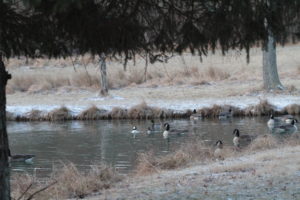
More recently a group of Ring Tailed ducks were out diving on the pond. Their is also a pair of Mallard’s that have been here all winter. The female has a bum leg which may be why they haven’t moved on.
Other (Human) Craziness…
When I bought the farm in 1997 there was a large dish antenna located near the side of the house. I managed to remove the dish and find someone who wanted it not too long often moving in but after numerous attempts to use the metal support pole for “something” I realized it had to go. Another example of how much things have changed in 20 years!
Last year I started digging around the concrete footings to scope the extent of the project. Needless to say I ran out of time as I was trying to put up a new fence around the vegetable garden and that had to take priority. Since the weather in Feb, was so lovely, I returned to the task. After I got down to over three feet, it finally dawned on me that even if I could get it completely uncovered there is no way I would be able to get it out of the hole and moved somewhere, not to mention where/how to get rid of it. I tried whacking the concrete with a sledge hammer for awhile and concluded this approach would work but I’d be nearly 80 years old before I’d finished. On to the next plan.
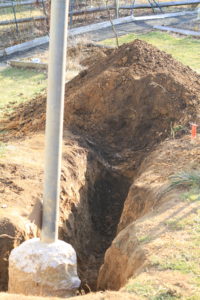
I decided to dig a trench, push it over horizontally and then cover it with dirt. Being buried under three foot of dirt would get it out of the way and wouldn’t get in the way of planting things over it. This plan also hit a snag as it turned out that there were two reinforcing rods that extended well past the bottom of the concrete foundation! After several attempts at pushing the concrete and pole over it had bent the metal rods enough that I could hacksaw through them. Success at last as the foundation and pole slowly bent over and into it’s trench grave! It only took about 45 hours of hand shoveling and 30 minutes sawing to see this amazing sight! The trench has been refilled, three blueberry bushes are planted on top and one end has sprouted grass. Definitely a project only a crazy person would have done themselves by hand!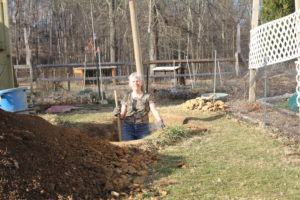
On to snowblower and lawn tractor repairs!
Shetland Wool Week 2017 Free Pattern Released
Free Knitting Pattern
The official 2017 Shetland Wool Week ‘Bousta Beanie’ knitting pattern has been exclusively designed by Wool Week Patron Gudrun Johnston.
Knit the hat in any of the suggested colour variations, or come up with your own colour scheme, and wear it to Shetland Wool Week 2017 – identify your fellow Wool Weekers and compare hats at the opening ceremony!
To receive the pattern all you need to do is complete the form (at link below), and remember to share your pictures using #boustabeanie or #shetlandwoolweek2017, we can’t wait to see your creations.
Ravelry Source = https://www.ravelry.com/patterns/library/bousta-beanie
If Alicia Silverstone was naked and telling you all wool clothing was bad, would you believe her?
Not I….as an animal lover and long time sheep and goat owner I can say with confidence that fiber animals need to be shorn for their health and it does not have to be a frightening experience. They don’t like having their feet trimmed either but if left untrimmed they would go lame. Nature is far more cruel than a caring owner, and every second of life is not completely idyllic for any of us.
*****************************************************************************************
If Alicia Silverstone was naked and telling you all wool clothing was bad, would you believe her?
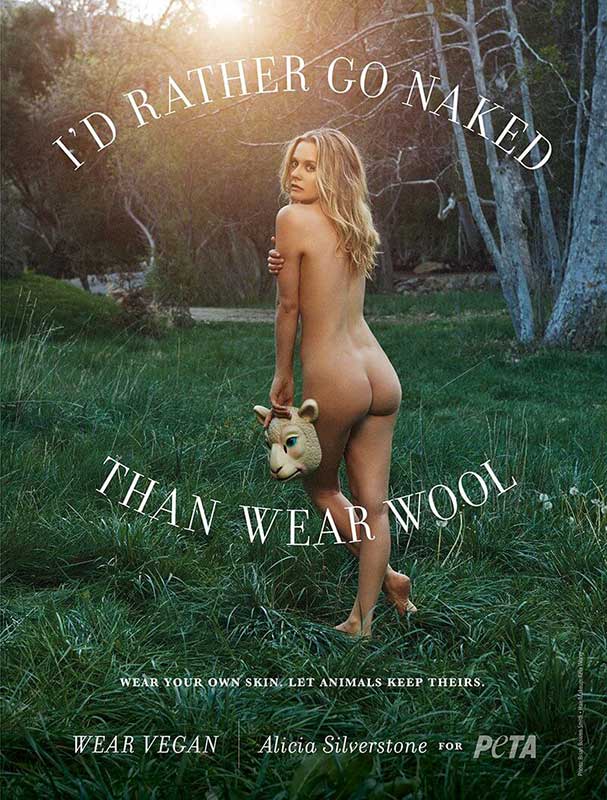
PETA, the animal rights organization, has a reputation for employing the oldest marketing trick in the book: selling their message with sex.
The latest example? Their campaign to raise awareness of animal abuse in the wool industry, which features a poster of Alicia Silverstone walking naked into a meadow, her head turned over her shoulder, looking back at you with seductive, pleading eyes. The caption reads, “I’d rather go naked than wear wool.”
Pamela Anderson, the singer Pink, and a handful of other celebrities have also bared all for the cause.
The PETA creed is that “animals are not ours to eat, wear, experiment on, use for entertainment, or abuse in any other way.” In other words, keeping livestock for purposes of human consumption, whether in a factory-farming setting or a small organic farm, is ethically reprehensible. PETA is well known for popularizing veganism and exposing animal rights abuses around the world. But livestock farmers, unsurprisingly, have long despised their shock and awe tactics, which have a tendency to paint all farmers as evil animal abusers.
PETA’s current sheep campaign—typically broadcast with the tagline, “there is no such thing as humane wool”—was launched in 2014 after the organization released footage of sheep being cut, manhandled, and mangled at wool-shearing operations in the US and Australia. The effort got major press coverage around the world, and led to the prosecution of several of the Australian shearers who were depicted in the footage on animal abuse charges. Now that Alicia Silverstone has put her skin in the game (pun intended), PETA’s wool campaign is back in the media once again.
Wool producers, along with a number of large agriculture organizations, have fought back. In Australia, the Victoria Farming Federation filed a formal complaint when a locally popular vegan musician was featured in PETA ads holding a bloodied lamb carcass with the caption, “here’s the rest of your wool coat.” It turned out the carcass was made of Styrofoam. PETA admitted to using a prop, but maintains that it was a realistic illustration of the horrors of shearing.
A skilled shearer needs just two minutes per sheep, and at worst, leaves a scrape or two no more gory than minor shaving cut. As far as viewing the sheep’s resistance to the practice as an indicator of cruelty, she suggests one might consider the challenges of bathing an uncooperative child or dog.
Animal abuse is far too common an occurrence with pets kept by demented individuals everywhere. And as PETA’s undercover sheep investigation clearly shows, along with many others that have preceded it, some abusive individuals (unfortunately) make their living handling livestock on farms throughout the world. The question is, is abuse the norm? Are examples of abuse at a few sheep ranches enough to indict an entire industry?
We thought it would be worth asking a wool producer who claims to raise their sheep in a sustainable, humane manner how their practices differ from what PETA ascribes to all wool producers. Becky Weed, owner of Thirteen Mile Lamb & Wool Company in southwestern Montana, was a little reluctant to take the call from Modern Farmer, as she’s been caught in the crosshairs of the animal cruelty debate before and has better things to do than argue with activists about whether or not raising sheep is inherently evil.
“I am wary of PETA,” says Weed, right off the bat. “I don’t think it’s a particularly rational organization…I think animal welfare is important, but I don’t believe that raising sheep is by definition cruel.”
Her harsh words stem from PETA’s unwillingness to acknowledge the many farmers who make humane animal care a top priority, throwing animal-loving ranchers like Weed under the bus as they expose the horrors of the industrial livestock industry.
Weed, who also operates an artisanal-scale solar-powered wool processing facility on her property, says she would like to think that PETA would see folks like her as an ally. Her farm is certified organic, she goes above and beyond the most stringent animal welfare standards, and her sheep have free range on pristine Montana prairie. With 160 acres for her 100 or so ewes, Weed’s sheep are stocked at an extremely low density that’s good for the animals and good for the land. She says PETA would have the support of a lot more farmers if they didn’t paint them all the same way.
“There are things that happen in industrial farming that are outrageously indefensible,” says Weed. “Like cramming poultry in tiny cages, putting cattle in feedlots where they are standing in their own manure up to their knees, and feeding ruminants a diet heavy in grains when they have evolved to live on grass. I’m the last person who will defend them. But practices like shearing sheep just pale by comparison. I wish they would focus their efforts where the really serious problems are.”
PETA is correct, says Weed, in noting that sheep often resist being shorn and must be restrained. It’s also true that minor cuts and nicks are part and parcel to shearing, though Weed says the savage shearing shown in the PETA videos, where some sheep appear to have massive wounds with loose, bloodied flaps of skins visible, are signs of either a demented, or untrained and extremely careless, shearer.
A skilled shearer, she says, needs just two minutes per sheep, and at worst, leaves a scrape or two no more gory than minor shaving cut. As far as viewing the sheep’s resistance to the practice as an indicator of cruelty, she suggests one might consider the challenges of bathing an uncooperative child or dog. They don’t love it, but it’s one of those necessary inconveniences.
Wild sheep naturally shed their thick winter coat in spring, but domesticated sheep have been bred over millennia to have an unnaturally thick coat, which, as we’ve reported before, never stops growing. Older sheep become accustomed to the routine and put up little or no resistance. Perhaps they realize it’s for the best: after several years without shearing, the wool becomes suffocatingly hot and can restrict the sheep’s movement.
Excess wool also predisposes sheep to infections and parasites, which is why the American Society of Animal Science responded to PETA’s sheep campaign with one of their own. The tagline read: “There is no such thing as humane wool when it is left on the sheep.”
Weed says “our sheep act super happy and animated after they get shorn…they seem happy to get rid of their wool. Occasionally there may be some cuts, but I’d wager I cut and bruise and bleed more often myself working on the ranch than my sheep do when they’re shorn. I think it’s one of the least cruel things that happens to animals in agriculture.”
We invited PETA to respond to Weed’s assertion that shearing, when done right, is benign. We also inquired whether they agreed that there is typically a big difference in the treatment of animals at industrial livestock operations versus small-scale producers. We sent them a series of questions to this effect to which they replied only with the following statement:
“Sheep are prey animals, so unless they’re left alone, they’re terrified. The size of the farm doesn’t matter. Even on small farms, they’re often herded with vehicles or dogs, forced into a shearing shed, and pinned down and sheared. Even the most careful shearer often cuts these struggling, panicked, and stressed animals. The only way to ensure that no sheep has suffered for our clothing is to shop vegan.”
Becky Weed would certainly contend that there are indeed humane sources of wool clothing available. She’s one of 44 humane wool producers in North America certified by Animal Welfare Approved. And there is a new wool-specific welfare certification on the humane livestock scene, which is called the Responsible Wool Standard. They just certified their first producers this year: two in Australia, one in Uruguay, and one in Oregon.
Pushed by major clothing brands, such as Patagonia, Eileen Fisher and H & M, RWS is geared for the large-scale producers that supply the vast majority of the world’s wool supply, and came about in part due to the negative publicity generated by the PETA exposé.
So even if the group’s point of view is a little, shall we say, un-nuanced, perhaps PETA is still giving a needed boost to the ethical livestock movement anyways by helping to convince the world’s largest livestock operations that consumers actually do expect them to provide the same level of care for their animals as is often found on the smallest of family farms.
Source: https://modernfarmer.com/2017/01/alicia-silverstone-naked-telling-wool-clothing-bad-believe/
